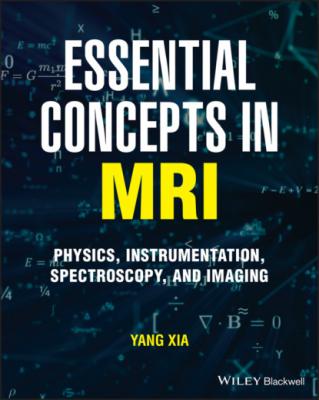Essential Concepts in MRI. Yang Xia
Читать онлайн.| Название | Essential Concepts in MRI |
|---|---|
| Автор произведения | Yang Xia |
| Жанр | Медицина |
| Серия | |
| Издательство | Медицина |
| Год выпуска | 0 |
| isbn | 9781119798248 |
Figure 3.4 Schematic log/log trends of relaxation times on the correlation time τc, which also depend upon the resonance frequency and temperature (not shown). T1 relaxation time has a minimum, occurring when ω ~ 1/τc. This minimum separates two regimes of relaxation. On the left of the minimum is the extreme narrowing regime (ω ≪ 1/τc) where T1 ~ T2, where one can find the reduction of the homogeneous line width (1/πT2); one commonly finds simple and less viscous liquids of small molecules in this regime. On the right of the minimum there is a regime (ω ≫ 1/τc) where T1 and T2 diverge significantly; one can find in this regime viscous liquids and polymers of relatively large and complex molecules, as well as a variety of biological tissues.
References
1 1. Abragam A. The Principles of Nuclear Magnetism. Oxford: Clarendon; 1960.
2 2. Blum K. Density Matrix Theory and Applications. New York: Plenum; 1981.
3 3. Poole CPJ, Farach HA. Theory of Magnetic Resonance. 2nd ed. New York: John Wiley & Sons; 1987.
4 4. Ernst RR, Bodenhausen G, Wokaun A. Principles of Nuclear Magnetic Resonance in One and Two Dimensions. Oxford: Clarendon; 1987.
5 5. Callaghan PT. Principles of Nuclear Magnetic Resonance Microscopy. Oxford: Oxford University Press; 1991.
6 6. Slichter CP. Principles of Magnetic Resonance. 3rd ed. Berlin: Springer-Verlag; 1992.
7 7. Callaghan PT, Eccles CD. Sensitivity and Resolution in NMR Imaging. J Magn Reson. 1987; 71:426–45.
8 8. Xia Y. Contrast in NMR Imaging and Microscopy. Concepts in Magn Reson. 1996; 8(3):205–25.
9 9. Bovey FA. Nuclear Magnetic Resonance Spectroscopy. 2nd ed. San Diego, CA: Academic Press; 1988.
10 10. Hennel JW, Klinowski J. Fundamentals of Nuclear Magnetic Resonance. Essex: Longman Scientific & Technical; 1993.
11 11. Bloembergen N, Purcell EM, Pound RV. Relaxation Effects in Nuclear Magnetic Resonance Absorption. Phys Rev. 1948; 73:679–712.
Notes
1 1 The Zeeman effect is named after Dutch physicist Pieter Zeeman for his 1896 observation of splitting of the optical spectral lines in a magnetic field.
Конец ознакомительного фрагмента.
Текст предоставлен ООО «ЛитРес».
Прочитайте эту книгу целиком, купив полную легальную версию на ЛитРес.
Безопасно оплатить книгу можно банковской картой Visa, MasterCard, Maestro, со счета мобильного телефона, с платежного терминала, в салоне МТС или Связной, через PayPal, WebMoney, Яндекс.Деньги, QIWI Кошелек, бонусными картами или другим удобным Вам способом.
